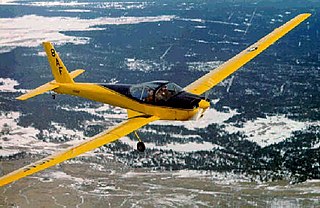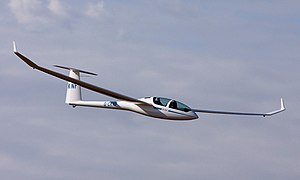A motor glider is a fixed-wing aircraft that can be flown with or without engine power. The FAI Gliding Commission Sporting Code definition is: a fixed-wing aerodyne equipped with a means of propulsion (MoP), capable of sustained soaring flight without thrust from the means of propulsion.

The Consolidated Vultee XP-81 is a development of the Consolidated Vultee Aircraft Corporation to build a single seat, long range escort fighter that combined use of both turbojet and turboprop engines. Although promising, the lack of suitable engines combined with the end of World War II doomed the project.

The Bensen B-8 is a small, single-seat autogyro developed in the United States in the 1950s. Although the original manufacturer stopped production in 1987, plans for homebuilders are still available as of 2019. Its design was a refinement of the Bensen B-7, and like that aircraft, the B-8 was initially built as an unpowered rotor-kite. It first flew in this form in 1955, and on 6 December a powered version, designated B-8M first flew. The design proved to be extremely popular and long-lasting, with thousands of sets of plans sold over the next thirty years.

The Schempp-Hirth Duo Discus is a high-performance two-seat glider primarily designed for fast cross-country flying, including gliding competitions. Often, it is used for advanced training.

The Glaser-Dirks DG-100 is the first sailplane manufactured by Glaser-Dirks. It is a standard class glider designed by Wilhelm Dirks in 1974 and developed from the Akaflieg Darmstadt D-38.

The L-13 Blaník is a two-seater trainer glider produced by Let Kunovice since 1956. It is the most numerous and widely used glider in the world. In United States Air Force Academy service, it is designated TG-10C and was used for basic flight training up to 2012.

Boeing XB-55 was a proposed Boeing aircraft designed to be a strategic bomber. The XB-55 was intended to be a replacement for the Boeing B-47 Stratojet in United States Air Force (USAF) service.

The Glaser-Dirks DG-400 is a single-seat self-launching motorglider that was produced by Glaser-Dirks between 1981 and 1992. It was the first self-launching motorglider with retractable engine and propeller to be produced in large numbers.

The TG-10 is the military designation for the Blanik, Super Blaník and Blanik L-33 Solo Czechoslovakian sailplanes used for basic flight training at the United States Air Force Academy. The Academy maintained an inventory of 21 TG-10s, in these three variants, until 2012. The aircraft were flown by cadets and officers of the 94th Flying Training Squadron, 306th Flying Training Group, Nineteenth Air Force, Air Education and Training Command.

The 8GCBC Scout is a two-seat, high-wing, single-engined fixed conventional gear general aviation airplane that entered production in the United States in 1974. Designed for personal and commercial use, it is commonly found in utility roles such as bush flying—thanks to its short takeoff and landing (STOL) ability—as well as agriculture, pipeline patrol, and glider and banner towing.

The Slingsby T67 Firefly, originally produced as the Fournier RF-6, is a two-seat aerobatic training aircraft, built by Slingsby Aviation in Kirkbymoorside, Yorkshire, England.

The RFB Fantrainer is a two-seat flight training aircraft which uses a mid-mounted ducted fan propulsion system. Developed and manufactured by German aircraft company Rhein-Flugzeugbau GmbH (RFB), it has been used by the Luftwaffe and Royal Thai Air Force.

The Darmstadt D-22 was a sports-plane of Germany, designed and built by Akaflieg of Technische Universität Darmstadt.

The Glaser-Dirks DG-500, and later the DG-505, is a two-seat glider of glass-reinforced plastic and carbon fiber reinforced plastic construction, manufactured in the DG Flugzeugbau GmbH in Bruchsal, Germany. It first flew in 1987.

The Schneider Grunau Baby was a single-seat sailplane first built in Germany in 1931, with some 6,000 examples constructed in some 20 countries. It was relatively easy to build from plans, it flew well, and the aircraft was strong enough to handle mild aerobatics and the occasional hard landing. When the Baby first appeared, it was accepted wisdom that the pilot should feel as much unimpeded airflow as possible, to better sense rising and falling currents of air and temperature changes etc.

The Schweizer SGM 2-37 is a two-place, side-by-side, fixed gear, low wing motor glider.

The Stemme S10 is a self-launching sailplane produced by Stemme AG in Strausberg (Germany) since the 1980s. The engine is mounted amidships and it features an unusual folding propeller which is stowed inside the aircraft's nose-cone when the engine is not in use.

The Scheibe SF-25 Falke is a German touring motor glider developed from the earlier Bergfalke glider by Scheibe Flugzeugbau. Since May 2006 the business has been run by Scheibe Aircraft GmbH.

The Akaflieg Berlin B13 is a two-seat motor-glider designed and built in Germany.

The Glaser-Dirks DG-600 is a glider manufactured by Glaser-Dirks as a successor to the DG-202 and DG-400 series of gliders where carbon fiber reinforced plastics was used.




















